by Winding Pathways | Sep 19, 2024 | (Sub)Urban Homesteading, 1080 Labyrinth Blog, Garden/Yard, Nature, Wonderment
Partnership with Sustainable Landscape Solutions Creates Natural Beauty
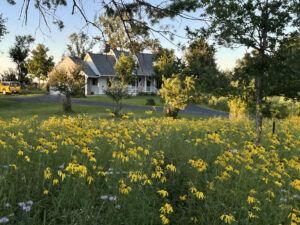
Brilliant flowers
When we bought our home near Cedar Rapids in 2010 we had a vision to transform the yard that had been sprayed and manicured by its former owner into a wondrous place, brimming with natural beauty and fascinating wildlife. It would be a delightful yard with prairie and savanna wildflowers bouncing in the breeze, and goldfinches and swallowtail butterflies winging over. We sought to create natural beauty.
We have years of ecological restoration experience. Rich had been restoring prairies and oak savannas since 1975 in his position as executive director of two nature centers. Like Rich, Marion is an inspired naturalist and a labyrinth expert. Together we had managed our former home for diversity, but the new property offered more space.
Beginning almost immediately, we planted prairies in portions of our front and back yards and worked with Linn County Roads to restore prairie in the nearby road ditch. This helped hold runoff water that could percolate into the ground.
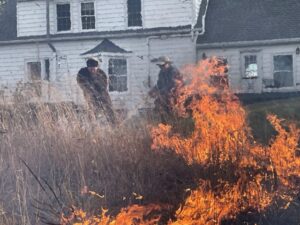
Working together.
Fortunately, we have experience managing fire. Rich is a former US Forest Service Hot Shot (wild firefighter) and we’ve used prescribed burns to help nurture the prairie. Burning has helped us resurrect native plants and wildlife.
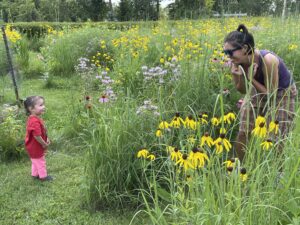
August – Joy is a part of labyrinths.
In their largest prairie Marion crafted the Phoenix Harmony Labyrinth. This is a five-circuit, dual-entry path to the center where people can enjoy a bur oak and be surrounded by prairie grasses and forbs. She welcomes people to play and encourages anyone wishing for moments of contemplation to visit and walk its curving paths between blooming prairie plants. Her labyrinth is listed on the international labyrinth locator registry.
How Sustainable Landscape Solutions
Helped the Pattersons
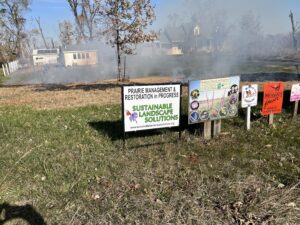
Several organizations and businesses are collaborating to create and manage the prairie.
We needed help with our newer projects. “We wanted to transform a hilly patch of our front lawn into a prairie rich in wildflowers and fewer tall prairie grasses. The site was a long-established conventional lawn composed of exotic grasses,” said Rich. “That’s a challenging environment to establish prairie. I’ve established prairies on lawns before by broadcasting seeds and following up with prescribed burns. But, it’s a slow process. We wanted to speed up restoration and needed help killing the turf and preparing the soil,” he added.
In 2020 we hired Sustainable Landscape Solutions to do the prep by first spraying the existing turf and later working the soil. Pattersons took it from there and planted a seed mix they purchased from Pheasants Forever. It’s called their Leopold Mix and contains seeds of 82 species of native prairie wildflowers.
Patience
It takes prairie time to mature. A year after planting we had a few blooms. The next year a few more. In its third year, it began to look like a prairie, and by its fifth growing season, the area was a magnificent spread of colorful flowers fluttering in the summer breeze. Alive with bumblebees, butterflies, and other insects, it was rich with life.
Next Steps
Four years later we decided to pursue a different sort of property upgrade. The 2020 Derecho did a job on a cozy nook next to the garage. “We wanted to transform a weedy nook south of our house into a delightful place to sit on cool spring and fall days where the sun would warm us. We worked with Virginia Hayes of Sustainable Landscape Solutions to come up with a patio plan that allows us and our visitors to sit and enjoy our thriving natural landscapes.
Patience, Again
Multiple rains delayed the project as Sustainable Landscapes worked diligently to catch up on already scheduled, and now rain-delayed projects. The new patio was crafted in July 2024. “It’s an example of how our company was able to work with homeowners to create a vision and gorgeous yard. Pattersons had much restoration knowledge but we’re happy to help people less experienced transform their yards into areas of natural beauty,” said Sean Pearl of Sustainable Landscapes.
-
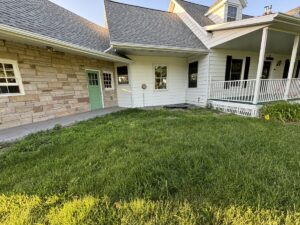
-
Weeds overtook the area
-
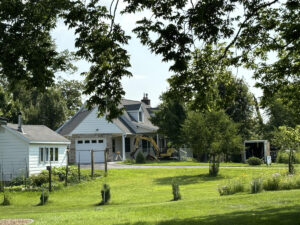
-
Small evergreens have replaced fallen Derecho trees.
-
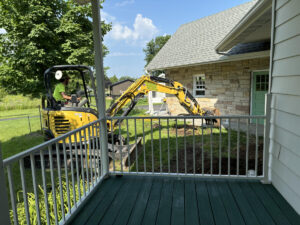
-
First removing dirt.
-
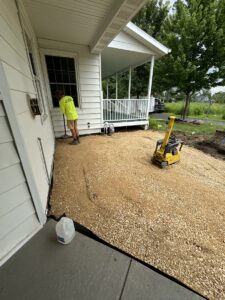
-
Next steps
-
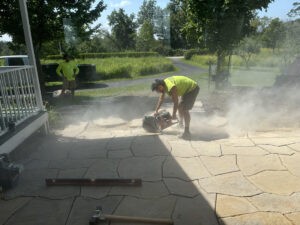
-
Dusty job
-
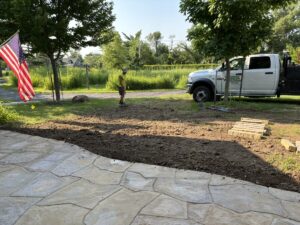
-
Water flows away

Coming together
Now, in early autumn, the nook is coming together nicely and we look forward to sharing it, the yard, and the labyrinth with others.
A Little More About Labyrinths
The Patterson’s labyrinth is created in a tallgrass prairie but these can be built in many ways, including in formal landscaping. “Many are made of bricks or pavers that enable a walker to negotiate the winding pathway,” said Marion. “Ours has a wide grassy path with borders of prairie grasses and forbs that change seasonally.” Labyrinths are structures with a path that winds to a center. Each time walkers follow the path around the center is called a circuit. Walkers find that the winding path slows down their minds and they can settle into a more relaxed space. Because of the natural setting, many walkers comment on how they recall times in nature as youth. Patterson is available to help landowners create labyrinths.
Blessings of the Changing Landscapes
We welcome visitors to our Winding Pathways website and to see our prairies.
by Winding Pathways | Aug 22, 2024 | Garden/Yard, Nature, Wonderment
Guest Blogger – Jacqueline Hull
Have you ever tried something fun as a gardener? Well, I have. My curiosity wondered if it were possible to root the head of a pineapple.
We love fresh pineapple. The head has to be cut off then the sides to get to the juicy pieces. Then, we stash the severed pieces in the compost pot for future use in the garden.
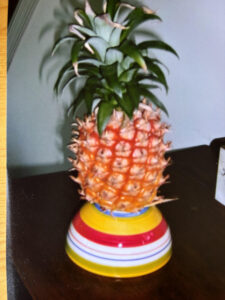
Will the pineapple take?
One day, after my husband, Peter, dissected our fresh pineapple, I retrieved the top piece and placed it into some moist potting soil. I made sure the soil was damp each day as I waited for it to root. After a time, to my delight, I discovered the head had indeed grown roots and was holding tightly to the soil.
For several years I fertilized and watered this pineapple as the spears grew larger and taller. I also transplanted it to a huge glazed pot.
Peeking down into the center of the plants one day, I saw a teeny tiny fruit that had developed. It kept growing and growing and eventually, a soft, golden color appeared in its greenery. It had about seven inches of fruit and I knew it was ready to be picked.
To our delight when we harvested the pineapple, the inside was sweet and juicy.
Now, we wait for the two that are growing on the porch to ripen. One has a fruit and we anticipate the other to develop its fruit.
Our adventure continues as we try to grow onions from pieces with roots and wonder if we could do the same with celery…maybe!
Editor’s note: Share your growing experiments with us on the comments page.
by Marion Patterson | Aug 1, 2024 | Garden/Yard, Mammals, Pests
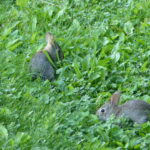
Young rabbits “play” to gain skills and show dominance.
Have you noticed the abundance of the cottontail rabbit this summer? While they can create mischief as in eating desired plants, they also are fun to watch.
Winding Pathway’s resident cottontail rabbits give us delightful evening entertainment. Shortly after sunset, a few appear like magic from out of our labyrinth’s tall prairie. As we sit on our porch they scamper about, chase each other, and nibble on the white clover poking out of our lawn.
Many people dislike cottontails for their habit of feasting on favored garden plants and gnawing on tree bark in the winter. Because we enjoy both rabbits and Swiss Chard, we keep them away from our vegetables and, thus, appreciate their antics.
Several cottontail species range across most of the United States, southern Canada, and South America. They’re well adapted to thrive in diverse environments. Ours is the Eastern Cottontail rabbit. This year they are especially abundant.
There are Rabbits and Then There are Rabbits
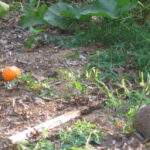
Side by side
Cottontails and common domestic pet rabbits may look similar but they are vastly different.
Pet Bunnies
Pet bunnies trace their ancestry to Europe and were domesticated thousands of years ago. They make fascinating and loveable pets and thrive in a safe roomy hutch eating commercial pellets. These are the rabbits that were released in Australia and caused enormous agricultural and ecological damage. They readily breed, are social, and join others to dig a series of burrows called warrens. Some readers may remember the award-winning novel, Watership Down, and the Netflix series about precocious rabbits.
-

-
Children and adults enjoy bunnies.
-
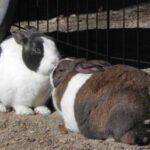
-
Rabbits are social.
-
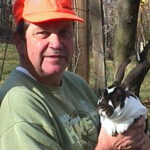
-
Friendly pets
-
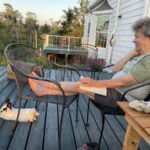
-
European rabbits adapt to people
-

-
Show animals.
-

-
Children with rabbits
Cottontail Rabbits
Cottontails, in contrast, are wild animals that rarely, if ever, become tame or make good pets. Like European rabbits they are social and like the company of other bunnies but not people. Cottontails don’t make burrows but sometimes enjoy ducking down an abandoned woodchuck hole. Cottontails live under dense vegetation, in culverts, and under outbuildings. They eat a wide range of wild plants but love snacking on vegetables. In winter they sometimes eat the bark off young trees. So, be sure to protect your young trees with wire mesh around the base.
-
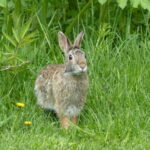
-
Time for an evening snack.
-
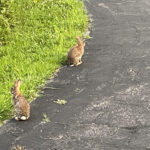
-
bunny play
-
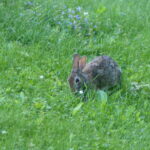
-
Nibbling clover
Enjoying Both Cottontails and Vegetables
Years ago, we learned a trick that lets us enjoy our resident cottontails and abundance from the garden. European rabbits are high jumpers, but not cottontails. Instead, native bunnies are long jumpers who can’t jump high. Just a wimpy two-foot-tall chicken wire fence around the garden or a young tree keeps them away as long as they can’t get under it.
-
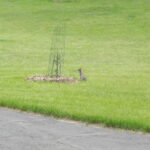
-
Keep rabbits away from young trees.
-
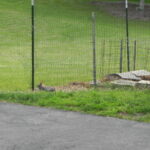
-
Cottontails cannot jump high.
Why So Many Cottontails This Year
For the past few years, Iowa has been in drought. It limited the new tender growth of clovers and other delectable plants that bunnies love. Sparse rain thinned thickets where they hide. This year’s been wet. Vegetation is tender and abundant yet we’ve not had big early thunderstorms. Why’s that important to a cottontail?
Before giving birth, a cottontail digs a shallow hole in the ground, often near the edge of a lawn. She lines it with fur and soon deposits three to eight tiny blind helpless babies. Mom mostly stays away but nurses them in the morning or evening by sitting over the burrow and letting her babies nurse. They grow amazingly fast and are out on their own when only about three weeks old. Mom soon gets ready for another litter.
Who Doesn’t Love a Cottontail Rabbit?
Predators love rabbits. They’re a favorite meal for dogs, cats, raptors, snakes, foxes, and coyotes. There are always rabbits because their survival strategy is to have many babies, even though only a small percent reach adulthood and reproduce.
Getting Rid of Cottontails
Well, why do it? They are inquisitive and beautiful animals that share yards with people.
An easy solution is to run chicken wire around desirable plants to keep them away. So, people can have their plants and rabbits, too.
Hooray for bunnies! They brighten our evenings as they scamper about our yard.
-
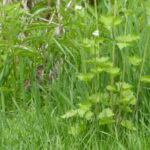
-
Rabbits know to stay hidden
-
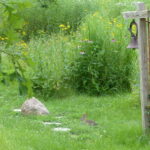
-
Cottontails live in the labyrinth.
-

-
Nibbling clover
by Winding Pathways | Jul 4, 2024 | (Sub)Urban Homesteading, Bugs, Garden/Yard, Garden/Yard, Nature
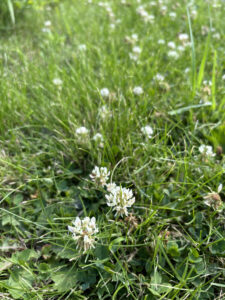
Mowers pass over low-growing clovers.
We recently discovered an amusing irony created by one of the most common lawn plants – white clover.
Sometimes called Dutch Clover, this low-growing plant graces unsprayed lawns in temperate regions across the globe. Normally, we discourage nonnative plants at Winding Pathways, but clover is an exception.
Although native to Eurasia, it’s not invasive. This important forage legume is likely the most widespread in the world. Diminutive clover is so low growing our mower passes right over its dainty flowers. Our friendly cottontail bunnies may seem to be eating grass, but actually, they’re feasting on clover. So are beneficial insects. As its flowers add beauty to the lawn and feed animals, clover’s roots pump nitrogen into the soil, helping other plants grow.
The irony
AI detected our Internet search for clover information. We began getting computer ads from landscaping companies encouraging us to hire them to kill our clover “and other weeds” in our lawn. No way!
Many people spend good money to poison beneficial lawn plants. They expose themselves, their pets, and anyone who walks on the lawn to toxic substances.
Maintaining a Healthy Bed of White Clover
White clover tends to gradually decline over the years. We’ve noticed this at Winding Pathways. To give it a boost we buy white clover seeds and sprinkle them on the lawn during cool months, especially on bare spots. Seed can be purchased online and in stores where hunters shop. These stores sell seeds beneficial to wildlife, and hunters often plant them to boost food for deer and wild turkeys.
-
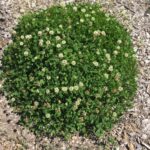
-
Clover can be manicured.
-
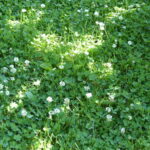
-
Sunlight on a clover lawn forms a cross.
-
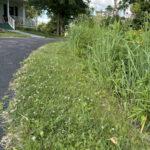
-
Dutch White Clover is low-growing.
Rewards
We have healthy lawns, rich with nitrogen. And, on summer mornings and evenings, we sit in our front porch’s rocking chairs watching bumble bees and bunnies foraging on our blooming white clovers. Thanks, clover.
-
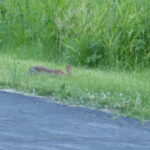
-
Bunnies enjoy clover.
-
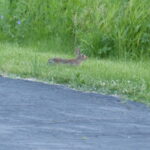
-
Watchful
by Winding Pathways | May 2, 2024 | (Sub)Urban Homesteading, Garden/Yard, Nature
Field Pussytoes delight us! (And, we plan to encourage them)
Early this spring a lawn care company dropped by and offered to spray our lawn. “We’ll keep the weeds out,” said the enthusiastic young man.
He knocked at the wrong door. We take joy in our lawn’s diversity, and soon after he visited delightful patches of Field Pussytoes sent up stems with their flowers in our lawn. Serendipity.
Field Pussytoes has the intriguing scientific name of Antennaria neglecta. Ours is one of several species of pussytoes that grace unsprayed yards. The word antennaria comes from the plant’s spikey flowers that look like an insect’s antennae. And neglecta? Well, because we are “neglecting” our lawn by not poisoning it, this humble plant thanks us. It needs little care and grows across much of North America.
This native plant thrives in conditions that describe most lawns. It enjoys full sun to partial shade, spreads by rhizomes, and is one of the earliest lawn “weeds” to flower. Its delicate blooms look like a kitten’s feet and toes. Field Pussytoes is pollinated by insects but bypassed by deer and rabbits.
Many years ago, Marion interviewed Lady Bird Johnson at the Lady Bird Johnson Wildflower Center near Austin, Texas. No doubt the former first lady enjoyed blooming pussytoes. The organization she formed has an outstanding website that helps anyone identify and enjoy plants.
Winding Pathways Lawn Management
We don’t neglect our lawn. We encourage native plants that need little care and which enrich the soil. As needed, we run a mower over it, but we’re always on the lookout for unusual plants that volunteer amid the grass. Some are delightful, and a few could be pests, but all are fascinating.
Our lawnmower helps us select the most interesting plants. Many that we might not want, like invasive sweet clover and garlic mustard, tend to grow tall. Our mower never gives them a chance. Field Pussytoes, like violets, hug the ground and escape the mower’s whirling blade. When done blooming, the plants form loose, sage-green mats that need no mowing at all! Gradually they’ve expanded.
One of the fundamentals of classic ecology is that diversity implies stability. Spraying a lawn destroys diversity, creating an unstable monoculture. We escape cost and possible chemical danger by not spraying our lawn. Pussytoes are just one of many fascinating plants that moved in and have spread on their own.
-
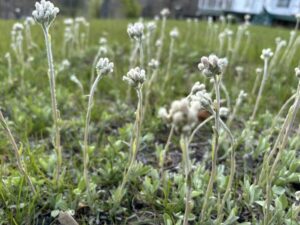
-
Blooms stand up several inches.
-
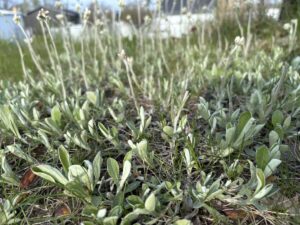
-
Field Pussytoes hug the ground
by Winding Pathways | Apr 18, 2024 | (Sub)Urban Homesteading, Garden/Yard, Garden/Yard
Spring Ritual
After this weird winter, most of us in North America are simply ready for spring and want to get outside. Some folks take initiative and start garden and flower seeds indoors then transfer them outside when the weather moderates.
Are you ready to work the land? Try something new: No-till Gardening.
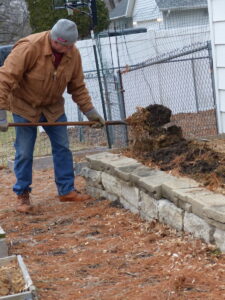
A rite of spring.
For generations, an April ritual all across the northern hemisphere is pulling the spading fork out of storage and firing up the rototiller. For generations, gardeners have learned from mentors, books, and videos that tilling is essential to create an abundant harvest of tomatoes, peas, beans, carrots, and so many other delicious garden vegetables.
Over decades and diligent research, we have learned that tilling is often just extra work that might harm the soil! Try no-till gardening.
Science Writer Shares Information
We recently heard science writer, author, and land steward Connie Mutel speak about how Iowa’s amazingly productive topsoil is being degraded by annual plowing and otherwise disturbing the soil. Mechanically mixing soil bares the soil to the air, where it oxygenates, leaching carbon into the atmosphere. When winds blow or rains fall, bare soil erodes. Waterways become contaminated and silt washes downstream eventually to the Mississippi Delta resulting in damage to commercial fisheries and wildlife there. According to Mutel, half of Iowa’s once 16-inch veneer of topsoil has been lost by tillage. For much more information check out her books available at the University of Iowa [email protected].
Reduce Runoff and Work
Most people aren’t farmers but many of us have backyard gardens. An annual activity is tilling. For years we followed conventional wisdom and used our trusty spading fork to turn over the soil each spring. Not so much anymore.
Last year encouraged by Drew Erickson, Farm Manager, of the Rodale Institute’s Midwest Organic Center, we left about half the garden untilled. “Tilling disrupts the organisms that make soil healthy and productive. “Try no-till gardening. Just plant your seeds in untilled soil,” he advised.
Last spring we tilled half the garden, smoothed out the soil, and planted our seeds.
We didn’t till the other half and just planted the seeds directly into the soil. A few months later we harvested at least as many vegetables from the no-tilled areas as the tilled……and we’d avoided the pitchfork work.
-
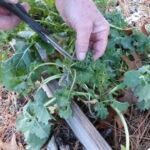
-
We planted kale directly into the ground with good results.
-
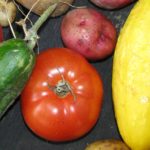
-
Summertime meal from the garden.
This year we’ll only till about a quarter of our garden. Into the rest we’ll plant our seeds and spread a layer of compost directly on the soil surface after the sprouts emerge.
We’re counting on bountiful harvests of many vegetables.
Join the Project
Give it a try. Put onion and potato sets, tomato plants, and bean seeds directly into the untilled garden soil. Let us know the results.
Learn More
Rodale Midwest is holding a free field day to show the value of minimum tillage and cover crops. It’s geared for farmers but gardeners are welcome. To register for the July 9, 2024, workshop go to the Rodale Institute Midwest Organic Center.
Have fun in the garden and enjoy a season of delicious vegetables.






































